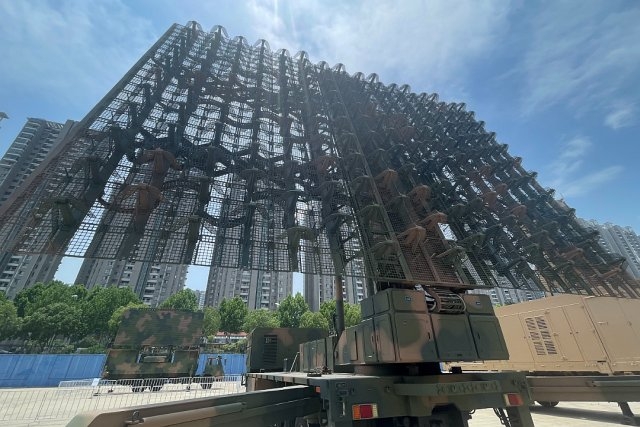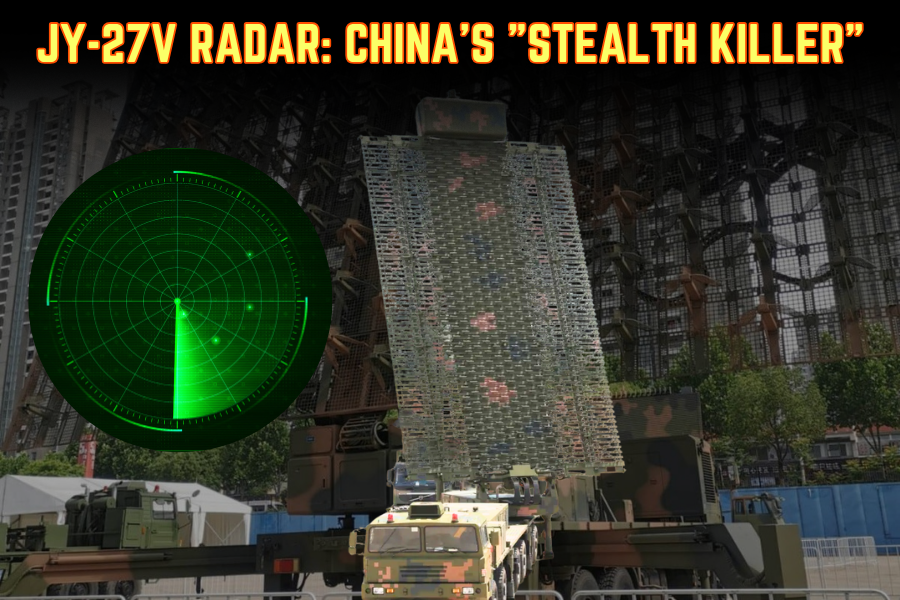(By Khalid Masood)
At the 11th World Radar Expo in Hefei, Anhui Province of China, on May 17, 2025, the JY-27V, a next-generation radar system branded as a “stealth killer” was unveiled. Developed by the China Electronics Technology Group Corporation (CETC), this mobile meter-wave radar is engineered to detect advanced stealth aircraft, such as the U.S. F-22 Raptor and F-35 Lightning II, challenging the dominance of low-observable technology. Alongside the JY-27V, CETC showcased complementary systems like the YLC-8E and SLC-7 radars, forming a robust anti-stealth detection network. Mounted on a military truck and deployable in ten minutes, the JY-27V combines mobility, advanced signal processing, and a large Active Electronically Scanned Array (AESA) antenna to pierce stealth’s veil. Yet, its untested real-world performance raises questions about its strategic impact. This article explores the JY-27V’s technical features, its role in China’s anti-access/area denial (A2/AD) strategy, the contributions of the YLC-8E and SLC-7, and their collective implications for global air power dynamics.
Technical Design and Capabilities of the JY-27V
The JY-27V operates in the very high-frequency (VHF) band (30–300 MHz), producing meter-long wavelengths (1–10 meters) that exploit a key stealth vulnerability. Stealth aircraft, designed to evade microwave radars (e.g., X-band, 0.01–0.1 meters), use radar-absorbing materials (RAM) and angular shapes to scatter short waves. Meter waves, however, interact with larger structural components like wings and tails, generating stronger echoes. CETC claims the JY-27V can detect the F-22 (radar cross-section ~0.001 m²) and F-35 at ranges exceeding 250 kilometers, leveraging its advanced engineering.
Its centerpiece is a massive AESA antenna, an upgrade from the JY-27A of 2016. The larger antenna enhances range and sensitivity, as CETC scientist Xu Haizhou noted: “The larger the antenna, the farther the range of detection.” The AESA’s hundreds of transmit/receive modules enable electronic beam steering, rapid scanning, and jamming resistance, surpassing older mechanical arrays. Its silent-folding mechanism allows deployment or retraction in under ten minutes, ensuring mobility on a military truck platform. This design reduces vulnerability to satellite or drone strikes, a lesson from the 2019 Israeli destruction of a Syrian JY-27 radar.
The JY-27V incorporates three advancements: a lower VHF frequency range, a high-power aperture, and AI-driven algorithms. The expanded frequency enhances anti-stealth detection, the high-power aperture boosts signal strength for distant low-observable targets, and intelligent software refines target discrimination and tracking in cluttered environments. CETC touts its ability to guide surface-to-air missiles (SAMs), making it a force multiplier in air defense networks.

Complementary Systems: YLC-8E and SLC-7 Radars
The JY-27V’s impact is amplified by its integration with other advanced radars showcased at the 2025 expo, notably the YLC-8E and SLC-7. The YLC-8E, a three-coordinate air surveillance radar operating in the ultra-high-frequency (UHF) band (300 MHz–3 GHz), complements the JY-27V’s VHF capabilities. Its antennas, integrated onto a single vehicle, feature high-precision sensors and automatic deployment/retraction, enhancing mobility. The YLC-8E employs a phased array system with 2D phased scanning and directional mechanical scanning, supported by large phased array antennas and high-efficiency digital transmit/receive units. CETC claims it provides long-range early warning and detection of stealth aircraft, with superior anti-jamming, reliability, and ease of maintenance. Its UHF band, with wavelengths of 0.1–1 meter, bridges the gap between VHF’s long-range detection and microwave radars’ precision, forming a layered defense.
The SLC-7, dubbed a “fourth-generation intelligence radar,” debuted publicly at the expo, showcasing multi-target detection, tracking, and engagement. Its strengths include a long detection range, high data rate, adaptive anti-jamming, fast target identification, and high reliability. The SLC-7 can search, identify, lock onto, and track multiple targets simultaneously, offering versatility beyond anti-stealth roles. It detects conventional fixed-wing aircraft, helicopters, drones, artillery, and rockets, making it a multi-role asset. CETC emphasizes its advanced signal processing and adaptability, positioning it as a cornerstone of integrated air defense systems.
Together, the JY-27V, YLC-8E, and SLC-7 create a synergistic network, with the JY-27V’s VHF band detecting stealth targets, the YLC-8E’s UHF band refining tracks, and the SLC-7’s multi-target capabilities guiding engagements. This layered approach enhances China’s ability to counter diverse aerial threats, from stealth jets to drones.
Strategic Context and Evolution
The JY-27V and its counterparts reflect China’s decades-long quest to counter U.S. air dominance, spurred by stealth platforms like the F-117 Nighthawk in the 1990s. Earlier systems, like the JY-27A and YLC-8B, reportedly detected F-22s over South Korea in 2016, though unverified. The JY-27V addresses past limitations in resolution and fire-control accuracy, while the YLC-8E and SLC-7 enhance network integration. Satellite imagery shows JY-27A deployments along the Line of Actual Control (LAC) in Ladakh and near Srinagar, monitoring Indian air activity. The YLC-8E’s mobility and SLC-7’s versatility suggest similar roles in contested zones like the Taiwan Strait and South China Sea.
China’s radar development aligns with its A2/AD strategy, deterring U.S. intervention in regional conflicts. The JY-27V’s rapid deployment and the YLC-8E’s automated setup make them ideal for dynamic battlefields, integrating with systems like the S-400 SAM and J-20 fighter. The SLC-7’s ability to track drones and rockets enhances China’s response to asymmetric threats, as seen in Houthi drone attacks on Saudi Arabia. In 2020, Venezuela’s JY-27 radar reportedly detected a U.S. F-22, though details are unconfirmed, underscoring the systems’ strategic messaging against U.S. stealth programs costing $428 billion for the F-35 alone.

Limitations and Challenges
Despite their advanced designs, the JY-27V, YLC-8E, and SLC-7 face inherent and practical challenges. Meter-wave (JY-27V) and UHF (YLC-8E) radars suffer from low resolution due to longer wavelengths, complicating weapons-quality tracks for missile guidance. The SLC-7’s multi-target tracking mitigates this, but requires seamless integration with higher-frequency radars, a complex task untested in combat. Environmental factors—terrain, weather, and electronic clutter—degrade VHF and UHF performance, while large antennas remain vulnerable to anti-radiation missiles or drone strikes. Indian sources claim their air force can neutralize Chinese radars like the JY-27A within hours using jamming or kinetic strikes, a threat the JY-27V’s mobility only partially counters.
The absence of independent testing is a critical gap. Chinese state media and CETC’s promotional claims, seen in earlier JY-26 and JY-27A hype, often outpace reality. Western analysts express skepticism, noting that detection is only part of the challenge; guiding missiles to fast-moving, low-observable targets demands proven coordination. Historical parallels, like Russia’s Nebo-M VHF radar, suggest detection is feasible, but consistent, actionable tracks remain elusive without combat validation.
Global Implications
The JY-27V, YLC-8E, and SLC-7, showcased together in 2025, signal China’s ambition to reshape air power dynamics. If their anti-stealth claims hold, they could erode U.S. tactical advantages, forcing stealth aircraft into riskier maneuvers—low-altitude flights, electronic countermeasures, or standoff weapons—each reducing mission efficacy. This shift may embolden China’s assertiveness in Taiwan and the South China Sea, where early detection of U.S. assets is pivotal.
Export potential amplifies their impact. Venezuela’s JY-27 and Algeria’s YLC-8B deployments suggest demand for Chinese anti-stealth systems. Nations like Egypt, countering Israel’s F-35s, may view the YLC-8E or SLC-7 as cost-effective, as reflected in X posts touting their affordability. However, U.S. countermeasures, including F-35 upgrades and sixth-generation platforms, indicate an ongoing technological race. China’s quantum radar research further escalates this contest, where innovation and adaptation define superiority.
Conclusion
The JY-27V, flanked by the YLC-8E and SLC-7, represents China’s bold challenge to stealth technology. The JY-27V’s VHF anti-stealth detection, the YLC-8E’s UHF early warning, and the SLC-7’s multi-target versatility form a formidable radar triad, enhancing China’s A2/AD strategy. Yet, their untested status, resolution limitations, and vulnerability to countermeasures temper their revolutionary potential. As symbols of China’s technological ascent, these radars force a reevaluation of stealth’s invincibility, but their true impact awaits combat’s crucible. For now, they stand as a testament to China’s resolve to redefine the skies of modern warfare.







